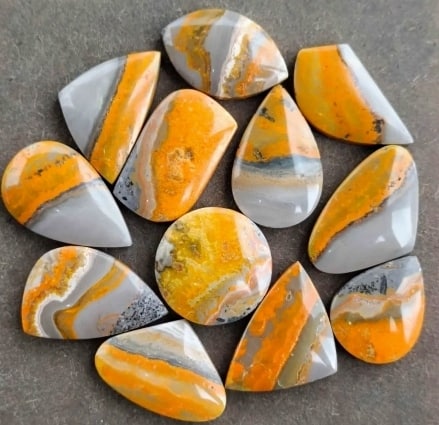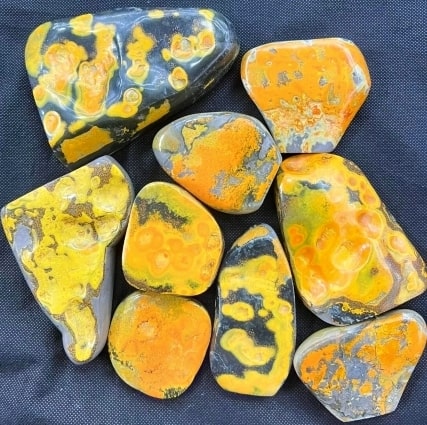Bumblebee jasper was discovered in the early 90s and rock collectors have been impressed with its bright stripes ever since.
Its name is derived from the close resemblance it has with a bumblebee. The orange, grey and black bands give it a bumble-like appearance.
What is this crystal made from? Where is it found? Is it actually jasper? Keep reading to find out!

What is Bumblebee Jasper?
Bumblebee jasper is not actually jasper, despite its name. It’s called bumblebee jasper because of its luster and patterns which make it look like traditional jasper.
The technical definition of jasper is an aggregate crystalline structure made from quartz or chalcedony. Both quartz and chalcedony are made from silicate, which is derived from sand and limestone.
True jasper ranks 7 or higher on Moh’s Scale of Hardness while bumblebee jasper is closer to 5.
Bumblebee jasper looks like jasper but lacks the quartzite crystal structure. It’s actually made up of a combination of sulfur, calcium, aragonite, pyrite, orpinite, and realgar. These minerals form into small stripes or bands and have a smooth exterior like jasper.
Is Bumblebee Jasper Toxic?
Some rockhounds are afraid to handle bumblebee jasper because of the presence of realgar. Realgar is a highly toxic compound and can be dangerous if inhaled or accidentally consumed. However, a polished piece of bumblebee jasper should be perfectly safe to wear as jewelry.
The short answer to the question is, yes, bumblebee jasper can be dangerous. However, it’s really only dangerous if you plan on polishing, cutting, and sanding the rock by yourself.
If you plan on customizing your bumblebee jasper, you should definitely be prepared. We recommend wearing gloves and a face mask to minimize inhaling rock dust while you cust and polish.
Bumblebee Jasper, Where is it Found?
Bumblebee jasper has only been discovered in Indonesia. Currently, the only known site is in Bali along the base of Mount Papandayan.
Mount Papandayan is part of a stratovolcano which is the most well-known type of volcano. They typically have a peak and are composed of layers of lava and tephra.
These volcanoes are typically steady exploders, meaning they don’t usually blow their top in one massive eruption.
The main supplier of this material is Indogate which handles most of the mining in this area.

Why is Bumblebee Jasper so Expensive?
One of the main reasons bumblebee jasper is so rare is that it’s difficult to collect. Since Mount Papandayan is an active volcano, miners need to journey inside a dangerous environment to gather these crystals. The other reason this crystal is so rare is that it requires unique conditions to form.
Most bumblebee jasper is gathered from the fumaroles of Mount Papandayan. This can be dangerous since you run the risk of falling inside the volcano or burning yourself on the hot vents.
This is definitely not a rock you should go rockhounding for on your own. This risky environment makes collecting difficult and dangerous, which adds to its scarcity.
Despite the difficulties in collecting this crystal, it isn’t very expensive. Most raw samples go for about $30.00 per pound. Or, a polished piece might cost $10-$20, depending on the size and quality.
What is Bumblebee Jasper Good for?
Everyone loves a cute bumblebee, except they sometimes sting us. Luckily, bumblebee jasper has the cuteness of this little bug without the painful stingers.
We hope this article helped you gain more appreciation for this unique mineral. Everyone should appreciate the bravery and ambition it takes for the local Indonesians to pluck these rocks from an active volcano!
Whenever you hold your little crystal, remember where it came from!
- Identify Enstatite - March 12, 2024
- Identify Cerussite - March 3, 2024
- Identify Bytownite - February 18, 2024

4 Responses
Do you have any advice on buying a piece ? Slabs vs towers vs spheres bs pieces cut for jewelry all end up with different patterns of black and yellow –
How do you tell what is a good piece for the price?
Margie – If you want to Jasper to hold it’s value over time then I would go with a traditional cabochon. Don’t go too large or too small.
A great piece would be one that can be used in jewelry if the owner chooses.
Price is negotiable and make sure you negotiate. Plenty of sellers of Bumblebee Jasper.
This was an article worth reading. I had been toying with the idea using bumblebee jasper to form part of a chess set. At 5 on the Mohs scale, it is likely too soft. Being so soft, am i right in thinking it will be porus and will need specific attention when cleaning and polishing?
Porosity has nothing to do with Mohs scale which means softer stones are not necessarily porous.
When it comes to polishing, you’ll want to match the stone with the correct polishing compound (tin oxide, aluminum oxide, chrome oxide…)
When it comes to cleaning, you’ll want to use soap and water most of the time but an ultrasonic will work as well. Be careful with stones that have been oiled or fracture filled.